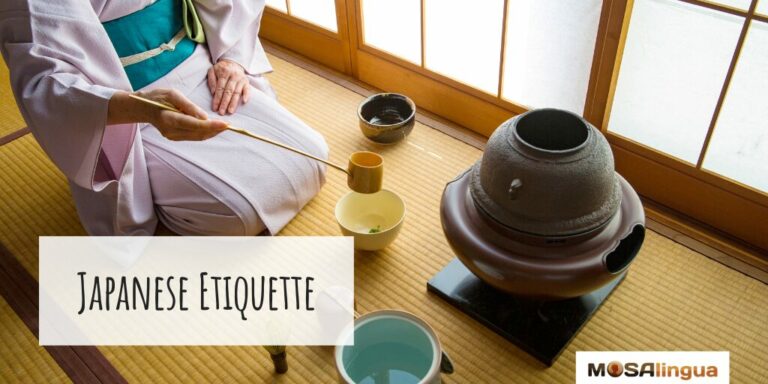In Japan, politeness occupies a central role in the culture and language. According to the context, you might need to use a specific vocabulary, verb forms, or special phrases. If you’re learning Japanese, this article will provide you with a foundation of all you need to know to make a good impression and be polite in Japanese.

How to Sound More Polite in Japanese: An Introduction
In English, we certainly have the concept of formal and informal language, and when it’s appropriate to use each. For example, you wouldn’t say “Hey, how’s it hanging?” to your boss, or “It was a pleasure meeting you” to your friends. In many languages, like French or Spanish, the distinction is even more concrete, as there are two different verbal registers of language to choose from – formal and informal. The principle is much the same in Japanese: you have to adapt the way you speak to the person you’re talking to.
Japanese manners demand that you address a superior differently. This special language, specific to formal situations, is called “keigo.” The changes between formal and informal speech in Japanese are much more significant than in English. So much so that it’s possible to learn only polite Japanese as if it were a language in its own right. This is what the famous “Minna no nihongo” method, widely used in college courses, proposes. It only mentions informal Japanese in its twentieth lesson. Before that, the book teaches only keigo, i.e. polite Japanese. As a result, it’s not uncommon to find reviews from students who are disoriented when they arrive in Japan: they’ve only learned the polite half of the Japanese language.
The polite forms apply in specific contexts, mainly at work or with strangers. Depending on the situation, there are degrees of keigo, but here we’ll concentrate on the polite/neutral forms in general. Once in the personal sphere, with friends or family, keigo has a variety of applications. Now let’s have a closer look at how to be polite in Japanese.
Being polite in Japanese: Verb forms
In Japanese, verbs are not conjugated according to the personal pronoun (they are invariable in that regard). Let’s take an example: the verb 見る (miru), which means “to see” / “to look.” Whether you want to say “I see,” “you see,” or “he sees”: it will invariably be 見る (miru). On the other hand, for the same conjugation tense, there will always be two forms: a neutral form and a polite form.
Thus, 見る (miru) is the neutral or colloquial form of the verb. It becomes 見ます (mimasu) in the polite form. If you’re interested in Japanese writing, you can see that the hiragana that forms the verb ending changes, but not the kanji that is used for the stem: 見る -> 見ます
It’s the context that will determine the politeness of the verb, regardless of the personal pronoun.
| Neutral context (family, friends) | Formal context (professional, strangers) | |
|---|---|---|
| I see | 見る (miru) | 見ます (mimasu) |
| you see (singular) | 見る (miru) | 見ます (mimasu) |
| he/she sees | 見る (miru) | 見ます (mimasu) |
| we see | 見る (miru) | 見ます (mimasu) |
| you see (plural) | 見る (miru) | 見ます (mimasu) |
| they see | 見る (miru) | 見ます (mimasu) |
You should also be aware that personal pronouns are often omitted in Japanese, and they too vary according to politeness… But more on that later.
The same applies to all conjugation tenses: there will always be a polite and a neutral form. For example, in the neutral imperative form, 見る (miru) becomes 見て (mite), and in the polite imperative form it’s 見てください (mitekudasai).
In some cases, the two forms can become very different from one another. Because of this, there’s a conception that it’s difficult to learn all the proper rules and to be polite in Japanese. In reality, the polite forms aren’t particularly difficult. They’re just different!
Choose the personal pronouns to be polite in Japanese
As mentioned above, Japanese generally does not use personal pronouns. When they do appear, it’s often to add emphasis to the person. (Example: Me, I love asparagus!) But if you do use them, it’s best to know the Japanese rules of politeness.
For example: わたし (watashi) is the pronoun most commonly used by textbooks to translate “I.” In a polite register, anyone can use it. But among friends, exclusively women use this pronoun. A man who says “watashi” with his friends will likely get strange looks.
It’s the same with other personal pronouns, which all have specific uses.
Being polite in Japanese: Vocabulary
As with verbal forms, Japanese vocabulary also varies according to the degree of politeness used. Some words clearly belong to the keigo register. This is the case, for example, with greetings. The famous “konnichiwa” (meaning “hello”) is reserved for a polite register, and we don’t say it to our friends.
You can adapt some words to polite situations with the addition of a suffix. To greet people in the morning, the Japanese use おはよう (ohayou) in the colloquial register and the expression おはようございます (ohayou gozaimasu) in the polite register.
The same phenomenon applies for “thank you.” ありがとう (arigatou) becomes ありがとうございます (arigatou gozaimasu) in the polite form.
Unfortunately, there are no rules for easily switching from a polite word to a neutral one or vice versa. Some endings, like “gozaimasu,” exist in several keigo expressions. But in other cases, the polite and neutral equivalents of the same word simply have nothing to do with each other. This is the case when talking about family members, for example. If I were talking about my own family in a formal context, I’d use the words 母 (haha) to mean “mother” and 父 (chichi) to mean “father.” To address my parents in a family setting, I would use the words お母さん (okaasan – “mom”) and お父さん (otousan – “dad”). The same goes for all family members: each has a neutral name and another polite one.
Polite suffixes in Japanese
A final point that influences Japanese speech is that of suffixes. Just as we say “sir” or “ma’am” in a formal setting, the Japanese use numerous suffixes after a person’s name to mark the degree of politeness required.
The highest polite suffix in Japanese is “-sama.” “Yamada-sama,” for example, indicates that Mr. Yamada is a very important, high-ranking person. Of course, you’ll have to use the keigo form throughout your conversation. This is the same suffix the Japanese use to address the gods: kami-sama. More surprising for Westerners, but very revealing of Japanese politeness: it’s also the suffix used to address store customers: okyaku-sama.
Next comes the suffix “-san.” Use this to speak with someone of slightly higher or equal rank, such as co-workers or classmates with whom you’re not particularly close. Then there are more familiar suffixes… But for close friends, it’s not necessary to use a polite suffix. However, if you forget to use an honorific suffix when you should, the effect can be insulting!
Conclusion
As I’m sure you’ve gathered, being polite in Japanese is a real skill, and it’s one that’s worth cultivating for anyone with an interest in traveling to Japan or working with native Japanese speakers. It’s not always easy to know exactly the right thing to say, or how to say it. Luckily for learners, another aspect of Japanese etiquette is to not make your interlocutor feel uncomfortable… So even if you make a slight misstep, a native Japanese speaker will avoid drawing attention to the error! So don’t be too hard on yourself, and learn from your mistakes.
About the author
Manon Perfetta is a French writer who specializes in all things Japanese. She has taught French as a foreign language to students around the world and is a true language lover. She’s been learning Japanese independently for several years.
VIDEO: How to Sound More Polite in Japanese
You can learn even more from Sarah, our own Japanese instructor. In this video, she highlights the main points of Japanese manners. It’s in English (and a little Japanese), but subtitles are available in several languages. You can turn them on by clicking on the Settings gear in the bottom right corner.
Sarah explains the concept of keigo, how to use its simplest form (teineigo), how to greet people with an ojigi, as well as a few other details such as etiquette within the home, how not to say “no” too directly, and also the volume of daily Japanese interactions.
Don’t forget to subscribe to our YouTube channel!
Go further
If you enjoyed this article, you might also be interested in:
Related posts:
Start improving your Japanese today

Good news: we can help!
More good news: you can get started for free! With your free trial, you can test drive the most effective way to learn Japanese for the next 15 days!
Vocabulary flashcards, videos with subtitles, audiobooks, articles adapted to your level—with MosaLingua Premium (Web & Mobile), you’ll have access to all this and more. Get started right now. It’s free—and risk-free—to try!





Comments